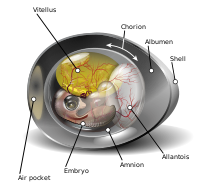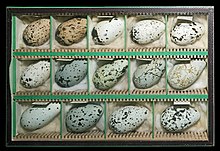The oviduct in vertebrates is the passageway from an ovary. In human females, this is more usually known as the fallopian tube or uterine tube. The eggs travel along the oviduct. These eggs will either be fertilized by spermatozoa to become a zygote, or will degenerate in the body. Normally, these are paired structures, but in birds and some cartilaginous fishes, one or the other side fails to develop, and only one functional oviduct can be found.

The black-headed gull is a small gull that breeds in much of the Palearctic including Europe and also in coastal eastern Canada. Most of the population is migratory and winters further south, but some birds reside in the milder westernmost areas of Europe. The species also occurs in smaller numbers in northeastern North America, where it was formerly known as the common black-headed gull.

An egg is an organic vessel grown by an animal to carry a possibly fertilized egg cell and to incubate from it an embryo within the egg until the embryo has become an animal fetus that can survive on its own, at which point the animal hatches.

Egg incubation is the process by which an egg, of oviparous (egg-laying) animals, develops an embryo within the egg, after the egg's formation and ovipositional release. Egg incubation is done under favorable environmental conditions, possibly by brooding and hatching the egg.

Oviraptor is a genus of oviraptorid dinosaur that lived in Asia during the Late Cretaceous period. The first remains were collected from the Djadokhta Formation of Mongolia in 1923 during a paleontological expedition led by Roy Chapman Andrews, and in the following year the genus and type species Oviraptor philoceratops were named by Henry Fairfield Osborn. The genus name refers to the initial thought of egg-stealing habits, and the specific name was intended to reinforce this view indicating a preference over ceratopsian eggs. Despite the fact that numerous specimens have been referred to the genus, Oviraptor is only known from a single partial skeleton regarded as the holotype, as well as a nest of about fifteen eggs and several small fragments from a juvenile.

Oviraptoridae is a group of bird-like, herbivorous and omnivorous maniraptoran dinosaurs. Oviraptorids are characterized by their toothless, parrot-like beaks and, in some cases, elaborate crests. They were generally small, measuring between one and two metres long in most cases, though some possible oviraptorids were enormous. Oviraptorids are currently known only from the Late Cretaceous of Asia, with the most well-known species and complete specimens found only in the Gobi Desert of Mongolia and northwestern China.
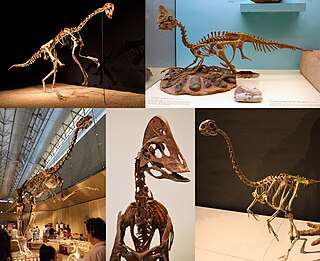
Oviraptorosaurs are a group of feathered maniraptoran dinosaurs from the Cretaceous Period of what are now Asia and North America. They are distinct for their characteristically short, beaked, parrot-like skulls, with or without bony crests atop the head. They ranged in size from Caudipteryx, which was the size of a turkey, to the 8-meter-long, 1.4-ton Gigantoraptor. The group is close to the ancestry of birds. Some researchers such as Maryanska et al (2002) and Osmólska et al. (2004) have proposed that they may represent primitive flightless birds. The most complete oviraptorosaur specimens have been found in Asia. The North American oviraptorosaur record is sparse.

An eggshell is the outer covering of a hard-shelled egg and of some forms of eggs with soft outer coats.

The king quail, also known as the blue-breasted quail, Asian blue quail, Chinese painted quail, or Chung-Chi, is a species of Old World quail in the family Phasianidae. This species is the smallest "true quail", ranging in the wild from southern China, South and Southeast Asia to Oceania, south to southeastern Australia, with 9 different subspecies. A failed attempt was made to introduce this species to New Zealand by the Otago Acclimatisation Society in the late 1890s. It is quite common in aviculture worldwide, where it is sometimes misleadingly known as the "button quail", which is the name of an only very distantly related family of birds, the buttonquails.

Nemegtomaia is a genus of oviraptorid dinosaur from what is now Mongolia that lived in the Late Cretaceous Period, about 70 million years ago. The first specimen was found in 1996, and became the basis of the new genus and species N. barsboldi in 2004. The original genus name was Nemegtia, but this was changed to Nemegtomaia in 2005, as the former name was preoccupied. The first part of the generic name refers to the Nemegt Basin, where the animal was found, and the second part means "good mother", in reference to the fact that oviraptorids are known to have brooded their eggs. The specific name honours the palaeontologist Rinchen Barsbold. Two more specimens were found in 2007, one of which was found on top of a nest with eggs, but the dinosaur had received its genus name before it was found associated with eggs.

Dinosaur eggs are the organic vessels in which a dinosaur embryo develops. When the first scientifically documented remains of non-avian dinosaurs were being described in England during the 1820s, it was presumed that dinosaurs had laid eggs because they were reptiles. In 1859, the first scientifically documented dinosaur egg fossils were discovered in France by Jean-Jacques Poech, although they were mistaken for giant bird eggs.

Dinosaur reproduction shows correlation with archosaur physiology, with newborns hatching from eggs that were laid in nests. Dinosaurs did not nurture their offspring as mammals typically do, and because dinosaurs did not nurse, it is likely that most dinosaurs were capable of surviving on their own after hatching. Although, parental care may have been required for some dinosaur species, as shown by fossil evidence. Dinosaur reproduction also required a mate; evidence of sexual dimorphism and courting displays have been found from fossil scrapings in sandstone and feathers on dinosaurs that lacked flight.

Elongatoolithus is an oogenus of dinosaur eggs found in the Late Cretaceous formations of China and Mongolia. Like other elongatoolithids, they were laid by small theropods, and were cared for and incubated by their parents until hatching. They are often found in nests arranged in multiple layers of concentric rings. As its name suggests, Elongatoolithus was a highly elongated form of egg. It is historically significant for being among the first fossil eggs given a parataxonomic name.
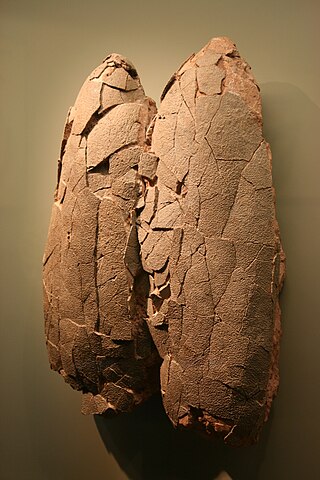
Macroelongatoolithus is an oogenus of large theropod dinosaur eggs, representing the eggs of giant caenagnathid oviraptorosaurs. They are known from Asia and from North America. Historically, several oospecies have been assigned to Macroelongatoolithus, however they are all now considered to be a single oospecies: M. carlylensis.
Continuoolithus is an oogenus of dinosaur egg found in the late Cretaceous of North America. It is most commonly known from the late Campanian of Alberta and Montana, but specimens have also been found dating to the older Santonian and the younger Maastrichtian. It was laid by an unknown type of theropod. These small eggs are similar to the eggs of oviraptorid dinosaurs, but have a distinctive type of ornamentation.
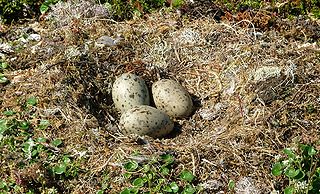
Clutch size refers to the number of eggs laid in a single brood by a nesting pair of birds. The numbers laid by a particular species in a given location are usually well defined by evolutionary trade-offs with many factors involved, including resource availability and energetic constraints. Several patterns of variation have been noted and the relationship between latitude and clutch size has been a topic of interest in avian reproduction and evolution. David Lack and R.E. Moreau were among the first to investigate the effect of latitude on the number of eggs per nest. Since Lack's first paper in the mid-1940s there has been extensive research on the pattern of increasing clutch size with increasing latitude. The proximate and ultimate causes for this pattern have been a subject of intense debate involving the development of ideas on group, individual, and gene-centric views of selection.
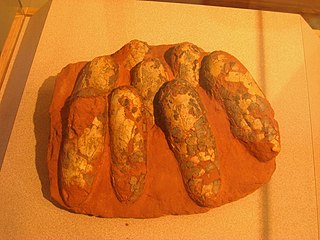
Elongatoolithidae is an oofamily of fossil eggs, representing the eggs of oviraptorosaurs. They are known for their highly elongated shape. Elongatoolithids have been found in Europe, Asia, and both North and South America.

Gobioolithus is an oogenus of fossil bird egg native to Mongolia. They are small, smooth-shelled, and elongated eggs that were first discovered in the 1960s and early 70s during a series of fossil-hunting expeditions in the Gobi desert. Two oospecies have been described: Gobioolithus minor and G. major. The eggs were probably laid in colonial nesting sites on the banks of rivers and lakes.

Beibeilong is a genus of large caenagnathid dinosaurs that lived in Asia during the Late Cretaceous epoch, about 96 million to 88 million years ago. The genus contains a single species, Beibeilong sinensis. The species was named and described in 2017 through analysis of an embryonic skeleton and partial nest with large eggs that were discovered in the Gaogou Formation of China between 1992 and 1993.

The egg of the ostrich is the largest of any living bird. The shell has a long history of use by humans as a container and for decorative artwork, including beads. The eggs are not commonly eaten.
